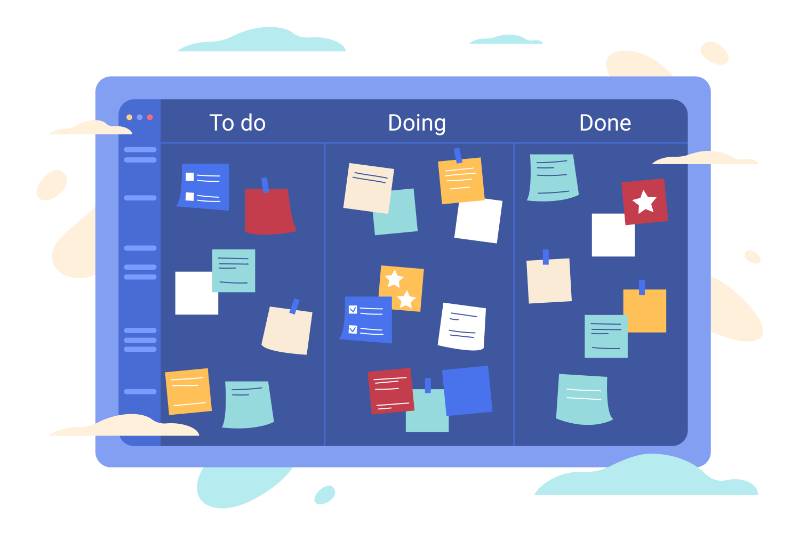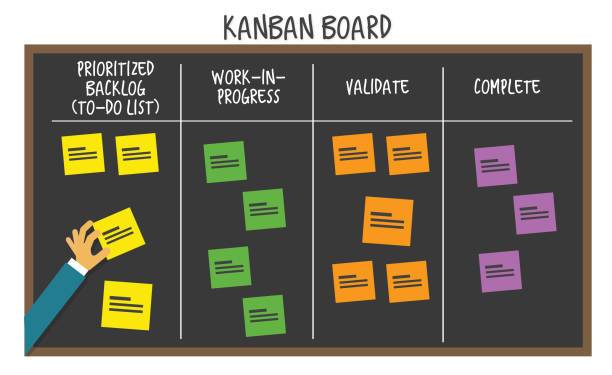Scrum is undoubtedly familiar to a lot of you. This framework applies an Agile approach to the creation, delivery, and maintenance of large projects, with a focus on application and software development. If you're unfamiliar with the approach, there are lots of Scrum materials available to help you get started.
Scrum puts a project on track through the Sprint, in which the team works towards one major objective within predetermined dates and communicates potential roadblocks to meeting the deadline. The Scrum board primarily acts as a visual medium for structuring tasks and tracking the team's productivity, which is crucial to the process. Every task is put on a separate card and set in the right column. Moreover, a Scrum board can do more than merely present tasks. This portion of our Scrum guide would go over the purposes of a Scrum board, how they operate, and why every team should be using one.
 What is a Scrum Board?
What is a Scrum Board?

A Scrum board is one of many project management tools that teams use to visually represent the items on their backlog. A sprint backlog is a collection of activities or products that your group will utilize to fill out your Scrum board. Team members regularly update their physical or digital Scrum board, which displays all tasks that must be done for the current sprint or time frame.
Digital Scrum boards offer numerous advantages, including the ability to update and show task situations in real-time. They enable teams to quickly determine in which the sprint lies and what objectives the team prioritizes.
Structure of a Scrum board
A Scrum board consists of the following columns:
- Stories - The stories on this board represent the most necessary factors of the scrum methodology. Stories bring context and evidence that the team is meeting required specifications via sequence and milestone-driven timely delivery. The team achieves this by making use of both digital and physical scrum boards.
- To do - A scrum board also refers to a digital file shown by a team for them and their stakeholders, such as the project leader and product manager. It provides one source of to-dos that includes the most up-to-date details, including the project's current situation, development, task allocations, and time estimations. This tool frequently includes data including the team's work plan and anticipated completion time, the sprint backlog, and the project timetable.

- In-Progress - Scrum boards are agenda-driven tools for tracking and showing ongoing tasks as a team or an individual. It displays information such as who is working on what and when. The scrum board layout helps teams to visually inspect the board and acquire an idea of current progress, keeping the team connected, on schedule, and moving forward.
- Done - Scrum boards on a whiteboard enable teams to set priorities, keep track of their work, as well as provide insight into work progress, ensuring that each individual is focusing on critical tasks. It also contributes to the ultimate purpose of the scrum strategy by removing roadblocks and maximizing the value as swiftly as possible in providing insights and transparency of the task's completion percentage.
 Types of Scrum Boards
Types of Scrum Boards
These Scrum boards are straightforward, easy to use, and comprehend, and they do not necessitate any advanced understanding of the Scrum board's many features.
If your team is going to use Scrum, the very first step is to choose whether to use a physical or digital Scrum board. Both offer advantages and disadvantages, but it is critical to examine your team's needs before sticking to a particular style. In this portion, we will go over how to utilize a physical and digital Scrum board in detail.
Digital board
You may also organize your Sprints by creating a digital Scrum board. The advantages of a digital board include real-time updates, personalization, and increased flexibility. Furthermore, many digital applications make it simple to collect all project data by allowing you to add papers straight to the board.
Digital boards are ideal for technology groups, fast-paced organizations, teams with remote employees, or situations where shareholders and investors require updates on project status. While digital boards can alleviate some of the challenges that physical Scrum board users encounter, they will not address all of your team's communication issues.
Preserving the Daily Scrum and emphasizing employee communication, on the other hand, is the greatest way to make sure that every task is accomplished by the end of every Sprint.

Physical Board

The first Scrum teams had been using a physical Scrum board to manage their stories, and yet many organizations still do currently. Physical Scrum boards are ideal for smaller and local companies where manual changes will not waste too much time or trigger communication difficulties.
If you decide to use a physical Scrum board, ensure you have solid communication channels in place to ensure that no work is ignored and that work status must be up to current. One method to accomplish this is to get the most out of the Sprint brainstorming session and retrospective, as well as to remain consistent with Daily Scrums.
Fortunately, physical boards encourage face-to-face communication, which is essential because Scrum depends on a close-knit team that interacts frequently and accepts their work as their own.
 How to use a Scrum Board?
How to use a Scrum Board?
Although physical and digital Scrum boards have the same principle, how you use them in your everyday work may differ. Here are the steps to make your own Scrum Board:
You must first create a board
You need to create your own grid. Keep in mind all of the crucial things that you do need to keep a record of in order to add a column to the overall procedure. Give every user story enough room and fill it up by the end of a sprint.
Divide each story into tasks
At this point, use sticky notes because each task will progress throughout the board when they are finished or in progress. Select a group member for each assignment and put his or her name on the sticker. Don't overload team members with numerous jobs at once; instead, begin with one and, once it is accomplished, developers can move on to another.
Performing project tasks

The members eventually take up the respective tasks listed on the Scrum board, as well as the things they pick to move from the to-do portion to the Scrum board's in-progress column. Members have to work on the project given tasks to them and, once completed, pick up new tasks from the Scrum board's to-do list.
Complete all of the tasks
When a member of the team completes a task, it transfers from the working part to the finished section of the Scrum board. In this scenario, the team member must return to the to-do list and select a new job to perform.
Reviewing
A Sprint Evaluation meeting is held during which all Sprint participants, as well as the Project Leader and Stakeholders, evaluation the Sprint and determine which tasks have been done. The Scrum Master checks if the team is experiencing any problems or barriers during the Sprint development cycle and proposes solutions. Just after Sprint is evaluated, it is set for a commercial launch for the team to begin their next Sprint.
 Benefits of using a Scrum Board
Benefits of using a Scrum Board
So now that you understood what a scrum board is, you should know how it might help your business. A well-executed scrum approach will undoubtedly improve the productivity of any project. Here are several benefits of using a Scum Board.
Improve Team Efficiency
Scrum boards function similarly to performance tracking tools used by software teams. They indicate who is completing chores quickly and who is taking longer than normal. Some of the critical changes that scrum boards enable you to make include reassigning responsibilities and splitting down assignments.
Assist in Problem Assessment

You can anticipate any problems that may arise if effective project tracking methods are in place. The team can divide their duties to guarantee that progress is maintained even when a member is absent. A scrum board, in conjunction with daily scrum meetings, is essential for dealing with any unforeseen situations.
Helps with Effective Planning
Scrum boards are quite useful in measuring your team's capability and the chances of meeting the project goals. Story points and burndown graphs, for example, enable you precisely assess each work item and make rational decisions for your upcoming sprints.
Encourage Transparency and Accountability
Scrum workers can be kept more responsible for their actions by using visible scrum boards and excellent communication. Scrum boards enable scrum masters to immediately give tasks to teammates in a transparent way.

 Who Should Use A Scrum Board?
Who Should Use A Scrum Board?

A Scrum Board can be a game-changer for many different types of teams and individuals. Here are some groups that can greatly benefit from using a Scrum Board:
- Agile development teams: Scrum Boards were initially designed for software development teams using Agile methodologies. They work wonders in helping teams prioritize tasks, track progress, and improve communication. If you're part of an Agile team, a Scrum Board is a must-have!
- Project managers: Juggling multiple projects at once? A Scrum Board can help you keep everything organized, ensuring that deadlines are met and resources are used efficiently. You'll be amazed at how easy it is to stay on top of your workload with a well-designed Scrum Board.
- Remote teams: Working remotely can be a challenge, but a Scrum Board can help bridge the gap between team members. It provides a central hub for tracking tasks, sharing updates, and discussing project-related issues, making it easier to stay connected and collaborate effectively.
- Creative professionals: Whether you're a graphic designer, a writer, or a marketing guru, a Scrum Board can help you break down large projects into manageable tasks, keep track of deadlines, and ensure that nothing slips through the cracks.
 Scrum board vs. Kanban board - Where is the difference?
Scrum board vs. Kanban board - Where is the difference?

Scrum and Kanban boards may seem similar at first glance, but they have some fundamental differences that set them apart. So, what makes them unique?
- Framework: Scrum is an agile project management framework that focuses on iterative development, while Kanban is a lean workflow management system designed for continuous improvement.
- Roles and Responsibilities: Scrum requires specific roles like Scrum Master, Product Owner, and Development Team, while Kanban doesn't have pre-defined roles.
- Iterations: Scrum operates in fixed time-boxed iterations called sprints, whereas Kanban focuses on continuous flow with no predefined time limits.
- Work in Progress (WIP): In Scrum, work is limited by the sprint's capacity, while Kanban uses WIP limits to restrict the number of tasks in progress.
 How to do Scrum in Edworking
How to do Scrum in Edworking
With the click of a button, you can create a quick task, naming it and giving descriptions or guidelines for your team to fully understand the task at hand. Label each column in any way you want, and select a related icon based on the column's function.
You can then create a task for each column you make. You can edit each task just like you would in Word. There is also a chat window for each task so that your team may collaborate more effectively.
When a job is completed and has to be assessed by the project leader, simply drag and drop it to the appropriate column, that’s how easy it is!

 Conclusion
Conclusion
Scrum boards are an excellent approach to improving your team's total capability through effective representation and interactivity. It will assist in making the overall process open and will foster a sense of personal responsibility among the team members.
If you are looking for a Project Management tool that offers a digital Scrum Board and many other features, and the best one is it's FREE, try Edworking now!





